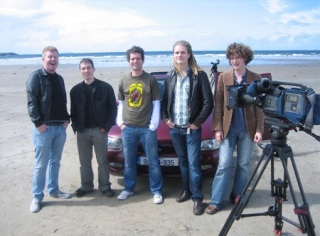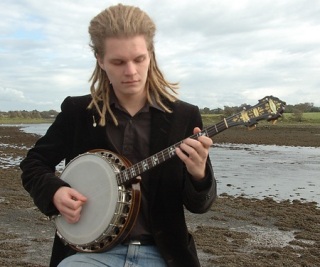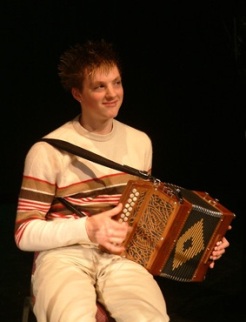
FolkWorld Issue 39 07/2009; Article by Seán Laffey
The Reel Deal
Trad on TV
The Reel Deal is a brand new seven part traditional music series which began Ireland’s National Public Broadcasters RTÉ 1 on Friday June 12th at 7.30pm. Seán Laffey has watched the series and says it’s strangely familiar.
A few weeks I got call from Tony McCarthy of Cork based Forefront Productions , would I mind if he sent me a preview set of the “Reel Deal” DVDs? Sure I said and within a day the discs arrived together with the PR blurb, which told me it was to be “an upbeat traditional music series with a contemporary twist.” Further the production company, Forefront TV, said “It is a lively, dynamic series for young people, featuring young performers and fronted by three engaging presenters; Aoibhinn Ní Shuilleabhan, Brian O’Connell and Bláthnaid Ní Dhonnchadha, who all share an interest in, and passion for traditional music.
 |
That it itself sounded, impressive, imaginative and intriguing. Long before the discs arrived I could guess the quality of the series as Joe and Tony McCarthy’s Forefront Productions has been behind some of the best traditional music shows on Irish TV. Yes this is the same team that brought us the Fleadh Programmes, Gradam Ceoil and of course their flagship offering Geantrai. Now don’t get me wrong I was excited about the new shows but a little nervous too, when you read media PR that talks about youth and uses terms like “lively, dynamic and engaging presenters” well I for one wondered if we were to be offered dumbed down trad. Once I put the discs into the DVD player, all those fears dissipated, it is a show for people who are thinkers not blinkers. If you are beyond the kid stage in life check it out, as it’s as much to do about new ideas as it is about fresh young faces. I found too that it has a much more considered and planned air about it than their flagship series Geantrai, which can sometimes come up slightly short because of its desire to document what is available locally. You see Geantrai is recorded live in a session pubs around the world and is more about the feel for the live music rather than a narrative investigation of it.
I’ll let you into a bit of a secret and give you a thumbnail RTE-guide style account of each episode of the Reel Deal , no details at this point as I wouldn’t want you to watch another channel when something as good as this is on the box. There will be some clips on the RTE Web site, currently excerpts from the first three shows can be found at http://www.rte.ie/tv and it is worth checking out Forefront TV (www.forefront.ie ) for some stuff , but alas to say there are no plans top market the series as a commercial DVD.
The first episode begins symbolically on Dublin’s Sean O’Casey Bridge, which is itself only four years old, it links the South side to the vibrant arts and commercial developments of the new North wall and it can swing open, momentarily breaking the link across the river only to close once again to keep the connection in tact. Brian O’Connell walks over the bridge and into the New Ireland, here old buildings are reused, refashioned and refurbished as we glimpse up river to views of Gandon’s 18th century masterpiece, which becomes a back drop to the future. In a swirl of camera work we flit between the three presenters who lay before us their mission statement, their view of the new territory of traditional music as complex, paradoxical, ephemeral and enduring as the landscape in which they stand, they speak directly to us:
“In the past traditional music was perceived by some as being old fashioned and the preserve of the older generation but there is now an awareness of the growing numbers of young people drawn to the music. The sound and style of the younger musicians certainly draws inspiration from past generations but is constantly changing, reflecting an air of confidence and experimentation not always found with older musicians.”
 I’ll let you judge for yourselves how closely they stick to this remit as you watch the series unfolds. Series Producer Tony McCarthy outlines what will be in each instalment.
I’ll let you judge for yourselves how closely they stick to this remit as you watch the series unfolds. Series Producer Tony McCarthy outlines what will be in each instalment.
In the first programme of the series we profile Tara Breen a young fiddle and flute player from Ruan in Co. Clare, we see how the internet has impacted on traditional music, we feature ‘Little Bird’ a guitar solo written and performed by Tim Edey, we meet Eamonn Galldubh a young Dublin piper who was influenced by fellow piper Mick O’Brien and we travel to Cork to go behind the scenes at the music and dance show ‘Dancing Thru the Ages’. In programme 2 we profile exciting young box player Damien Mullane, we explore the contrasts in the running of three of Ireland’s leading traditional music festivals. We also see that new ideas are not solely restricted to younger musicians when we showcase the Donegal choir Cór Thaobh á Leithid who sing the evocative ‘Pháidí a Ghrá’, we investigate the ever changing musical styles in traditional music and we bring together Sligo flute players Damien Stenson and Séamus Tansey. In programme 3 we go on the road with leading traditional group Beoga, we take our first look at the auditions to select the Irish Music Network Award recipients, fiddler Donal Donnolly and guitarist Brian Hanlon play for us a selection of reels and we profile a young musician from Dungannon Jarleth Henderson. Programme 4 starts in Co. Clare where we bring together two of the country’s finest concertina players Edel Fox and Noel Hill, we hear the beautiful song ‘Ned on the Hill’ from Donegal singer Shauna Mullin, we look at the options available in the education sector for traditional musicians, we profile Leitrim flute player David Sheridan and we delve into the art of Sean Nós dancing. In programme 5 we look at the etiquette required to partake in a traditional session, we pay our second visit to the Music Network Award auditions, the young group Morga entertain us with a set of reels, we profile American born fiddler Jessie Smith and we look at the craft of instrument making with pipes maker and musician Donnacha Dwyer. Programme 6 begins with a look at some of the foreign musicians who have been drawn to Irish music with Jonas Fromeiser from Denmark and South Africans Adam and Dave Shaperio, we also visit Na Píobairí Uilleann at their recently renovated home in Henrietta Street, there’s a wacky video from Beoga featuring the ‘Jazzy Wilbur set’, we ask about the relevance of Sean Nós singing among the young getting the views of Dominic Mac Ghiolla Bhride, Naisrín Elsafty and Éithne Ní Chatháin and we profile fiddler and composer Zoe Conway from Co. Louth. Programme 7 brings us back full circle to our beginning as we profile Kent guitarist and composer Tim Edey, we look at the great work being done by the Irish Traditional Music Archives, multi-instrumentalist Tara Breen plays a selection of tunes, Co. Cork musicians Sean McCarthy and Eoin Ó Riabhaigh come together to discuss their music and we end with a set of reels from the recipients of the coveted Irish Music Network Award, the group Fidil.
So there you have it. Now what did I make of it? The first thing to note is the videography is superb and this series is certainly shot with the capabilities of HD TV in mind. Secondly and here’s the big point, unlike other traditional music programmes, say TG4’s Geantrai or Blas Ceoil from the BBC, music performance isn’t the central part of each show, that might sound strange, but the format is such that only one or two numbers are played in their entirety, the reel deal here is that the youthful presenters skillfully weave in questions, tease out ideas and develop musical histories from the individual musicians. In essence it is not about the how or what of traditional music but about the why. Unlike other traditional music programmes the presenters act as questioning anchors rather than fellow travelers, For example the stock in tarde of Irish tard programming has been the way that player-presenters would pick up a fiddle to explore the ideas being discussed. That largely doesn’t happen here. In a sense it is back to the best of song collector Tom Munnelly who did so much to bring music to the TV screens in the 1970s, the essence is to let the singers, dancers and players tell their own stories.
 I think this reflects on the confidence and the maturity of the musicians themselves no matter what age they are, here they are able and articulate, open and honest about the music and this is hugely refreshing in itself. Gone is that cozy insider player-cum-presenter tasked with being the medium of explanation for a naïve public. The technical trick with the Reel Deal is that the interviews weave in over the top of performances.
I think this reflects on the confidence and the maturity of the musicians themselves no matter what age they are, here they are able and articulate, open and honest about the music and this is hugely refreshing in itself. Gone is that cozy insider player-cum-presenter tasked with being the medium of explanation for a naïve public. The technical trick with the Reel Deal is that the interviews weave in over the top of performances.
The more I watched the show the more I thought it was doing what we have been working on here at Folk World and at the day job at Irish Music Magazine (for the past 176 issues) ; giving the musicians time to tell us about their music. Of course with TV you also get to see them perform in their natural contexts.
You’ll find much to debate in the series; from the power of the web where the ambitious player has to become a brand in their own right , to getting noticed in magazines and newspapers which is seen to be essential in developing an artist’s career, where playing live is the ultimate test of ability, artistry and endurance; to the notion that what we call regional style is often more to do with the personality of very strong musical mentors, scratch a regional style and you’ll soon find an older teacher guiding the next generation. Running on from this we get some fascinating vignettes where teachers and pupils discuss their musical relationships and we discover how the music is transmitted.
Séamus Tansey in a Churchillian moment says that “Never before has so much good traditional music been made by so many” and we see that this is due in no small measure to the generosity of teachers and the interconnections across generations often in casual sessions. The web and in particular the invention of ABC notation has created databases and an active community which now exists to play, listen to, collect and debate the music. Traditional fiddler Toner Quinn puts it simply that the rise of the web now means we are know in a position to know how modern this traditional music really is, because we can look up the name of a tune and within minutes find out who wrote it and discover that they are alive and kicking, something which couldn’t have been traced a generation ago.
Will youth and cyberspace sustain the tradition? Not on their own. Throughout the series we see time and again both the older players and their young protégés coming back to the same fundamental answer, the best music is made by those with perseverance, chops and talent but most of all curiosity. When a teacher spots the child who has the sparkle in their eye, has the desire to hunt for old tunes from archives and their elders or as in the case of Tara Breen who plays along for half an hour each morning to CDs of Nova Scotia’s Natalie MacMaster “because the music is so it is challenging” we know they are both listening to and hearing the tradition afresh and enjoying it immensely. Or as Damien Mullane points out everyone starts out playing traditional tunes it is only when they are good enough they have the option to be Avant-garde, he also adds candidly that winning an All Ireland only means you pleased a few judges on the day and that its is not the be all and end all of performance.
I’ll leave the last word to my old pal Séamus Tansey who wryly says that if a teacher has done a good job in handing down the music they will be left with “A living monument of human flesh and blood.”
The Reel Deal is full of that and more.
| ‘The Reel Deal’ is a Forefront production in association with RTÉ. The series was funded under the Sound & Vision funding scheme of the Broadcasting Commission of Ireland. |
Photo Credits:
(1) Morga,
(2) Jonas Fromseier,
(3) Damien Mullane.
|
To the German FolkWorld |
© The Mollis - Editors of FolkWorld; Published 07/2009
All material published in FolkWorld is © The Author via FolkWorld. Storage for private use is allowed and welcome. Reviews and extracts of up to 200 words may be freely quoted and reproduced, if source and author are acknowledged. For any other reproduction please ask the Editors for permission. Although any external links from FolkWorld are chosen with greatest care, FolkWorld and its editors do not take any responsibility for the content of the linked external websites.
